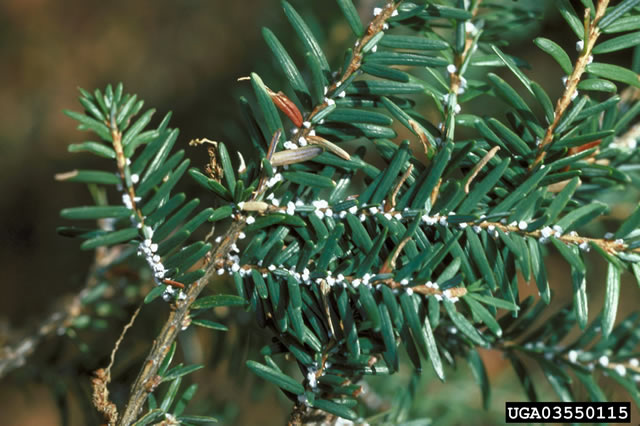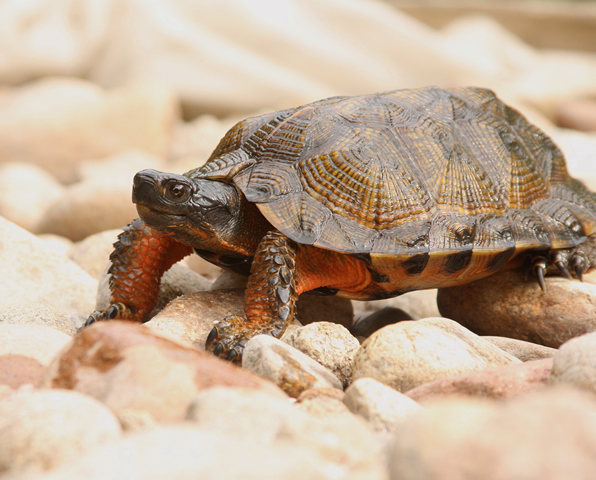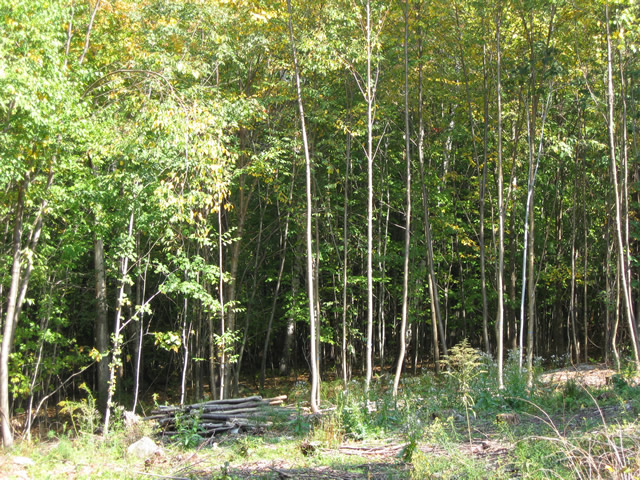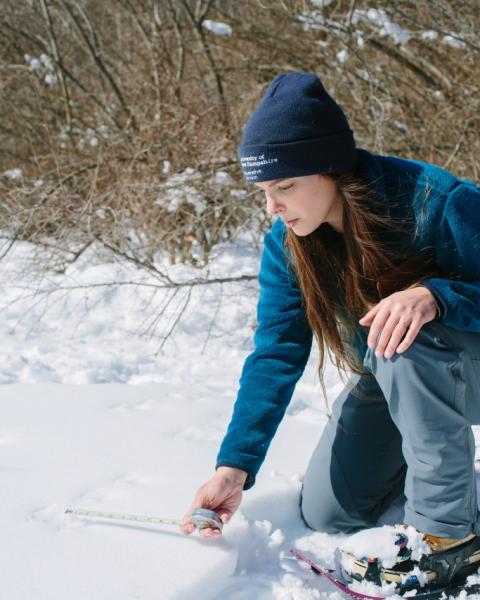Hemlock-hardwood-pine forest is the most wide-spread habitat in New Hampshire. considered the transitional forest habitat between lower elevations of Appalachian oak-pine habitat (<400’), and higher elevations of northern hardwood habitat (>1,500’), hemlock- hardwood-pine forests cover almost 50% of New Hampshire, most of it south of the white mountains.
White pine and eastern hemlock are most often the dominant trees, but these forests are highly variable and contain a mix of trees common in other forest types. In typical hemlock-hardwood-pine forests, you’ll also find beech and patches of sugar maple and white ash (on rich sites) and red oak (on drier sites). Under the canopy, look for small trees or shrubs such as witch hazel, maple-leaved viburnum, black birch, black cherry, and ironwood, with starflower and Canada mayflower on the forest floor.
Most white pine stands that have grown up from abandoned pastures are examples of this type of forest habitat. On fertile soils, white pine will be replaced over time by hemlock or hardwoods through a process known as forest succession. Although genuine old-growth forests are rare in New Hampshire, look for forests with old-growth features such as patches of large (>18” diameter) hemlock or beech in the canopy, layers of young trees and shrubs growing in the understory, many standing dead trees (“snags”), and abundant decaying wood on the ground. Large-sized cavity trees, pockets of wetlands, patches of acorn-rich oaks, seeps, and “supra canopy” pine trees (extra-tall pines that rise above the rest of the forest) make some areas of hemlock-hardwood-pine forest especially rich for wildlife.
Where are Hemlock-Hardwood-Pine Forests Found in NH?
Much of Belknap, Merrimack, Hillsborough, Cheshire and Carroll Counties are covered with hemlock-hardwood-pine forests, with excellent examples located at Five Finger Point in Tamworth, Sheldrick Forest Preserve in Wilton, and at University of New Hampshire’s College Woods in Durham. Hemlock-hardwood-pine forests are shown in the shaded areas of the map at right.
Why are Hemlock-Hardwood-Pine Forests Important?
Hemlock-hardwood-pine forests are the habitat that surround and support many smaller and unique habitat types in southern New Hampshire. Most wildlife that require vernal pools, marsh habitat, headwater streams, floodplains,shrublands, grasslands, or peat bogs will also use the surrounding forest to meet their needs for food, cover, or breeding. Hemlock-hardwood-pine forests are common, but shouldn’t be taken for granted given the important supporting role they play in the ecosystem.
Acorns and beech nuts in these forests (produced by mature oak and beech trees) are important food for many species including black bear, deer, ruffed grouse, chipmunk, squirrels and blue jay. In turn, raptors such as northern goshawk and Cooper’s hawk feed on small mammals and find nesting and perching sites in white pines in the tree canopy. Large areas of hemlock-hardwood-pine provide habitat for forest birds such as scarlet tanager, hermit thrush, Blackburnian warbler and black-throated green warbler.
Threats to Hemlock-Hardwood-Pine Forests
Habitat loss from development
The biggest threat to hemlock-hardwood-pine habitats in New Hampshire is the loss of these forests to residential and commercial development. New Hampshire has led New England with the fastest population growth for decades, and it continues to lead the region in loss of forestland. Development permanently eliminates habitat, affecting both forest-dwelling wildlife and animals that use forests as corridors between other habitats such as wetlands. Building and construction of paved roads separates wildlife populations, inhibits migration, increases predation and promotes wildlife-vehicle collisions on roads.
 Hemlock woolly adelgid
Hemlock woolly adelgid
The hemlock woolly adelgid is an insect introduced from Asia that targets both young and mature hemlock trees, killing them over time. A cottony substance on the underside of needles signals an infestation (see photo at right). Infested trees occur in many towns in southern New Hampshire. Preventative or control measures (e.g., insecticides) are ineffective for more than a few trees at time. If hemlock woolly adelgid results in fewer hemlocks in the forest, critical winter cover will be less available for wildlife such as deer, grouse, fisher, and porcupine, and will also negatively affect migrant breeding birds such as black-throated green warbler.
Uniformity
Many stands of hemlock-hardwood-pine forest in New Hampshire are the same age, roughly 80-100 years old. They grew back after extensive timber harvesting and abandonment of farms throughout the last century. Many wildlife species of conservation concern found in these forests are attracted to patches of old or young trees within the larger forest area. Today’s forests don’t support the same high diversity of wildlife species as older forests that contain a diversity of live and dead trees of different ages and sizes. Complicating matters, the public may prefer to view extensive, unbroken mature forest. As a result, managers are less likely to make large openings (e.g. clearcuts) that will re-grow into the young forests required by many wildlife species.
Climate Vulnerabilities of Hemlock-Hardwood-Pine Forests
- Because these forest types are so widespread, overall impacts from climate change are likely to be highly variable, and often limited by specific site conditions (soil, existing species composition, etc.). In general, hemlock-hardwood pine species are more likely to shift north or up slope, and replace those more typical of northern hardwood-conifer forests. The timing of such shift will vary considerably among species, and any migration is also likely to take place over timeframes longer than the present assessment considers. At the same time, Appalachian oak-pine forests may replace hemlock-hardwood-pine in some areas in southern New Hampshire.
- More frequent disturbance events (e.g., hurricanes, ice storms, tornadoes) will likely favor shade-intolerant, early successional species (paper birch and aspen) over shade tolerant, late successional species (beech and hemlock). Higher rates of disturbance would also alter the relative proportions of different seral stages of forest.
- Some forest pests are likely to increase with warmer and/or drier conditions (e.g., hemlock wooly adelgid). The adelgid in particular has the potential to remove significant amounts of hemlock and dramatically alter forest composition.
- Both disturbance and pest/pathogen related mortality could result in larger areas of salvage logging and resulting habitat changes. This could in turn affect nutrient cycling and local hydrology.
Click here for the Hemlock-Hardwood-Pine Climate Assessment, a section of the Ecosystems and Wildlife Climate Change Adaptation Plan (2013), an Amendment to the NH Wildlife Action Plan
Wildlife Found in Hemlock-Hardwood-Pine Forests
The wildlife species listed here are some of the wildlife that use hemlock-hardwood-pine forests. Be on the lookout for these species and follow stewardship guidelines to help maintain or enhance hemlock- hardwood-pine habitats. species of conservation concern—those wildlife species identified in the wildlife action plan as having the greatest need of conservation—link to their NH Wildlife Action Plan profiles.
- American toad
- American woodcock
- Barred owl
- Black bear
- Black-throated green warbler
- Blackburnian warbler
- Blanding’s turtle**
- Blue-spotted salamander
- Bobcat
- Broad-winged hawk
- Canada warbler
- Cerulean warbler
- Cooper’s hawk
- Eastern pipistrelle
- Eastern red bat
- Eastern small-footed bat
- Eastern towhee
- Flying squirrel
- Fisher
- Jefferson’s salamander
- Moose
- Northern goshawk
- Northern long-eared bat
- Pine elfin butterfly
- Porcupine
- Purple finch
- Red-breasted nuthatch

- Red-shouldered hawk
- Red squirrel
- Ribbon snake
- Ruffed grouse
- Silver-haired bat
- Six-spotted tiger beetle
- Smooth green snake
- Spotted turtle*
- Timber rattlesnake**
- Veery
- Whip-poor-will
- Wood nymph butterfly
- White-tailed deer
- Wild turkey
- Wood thrush
- Wood turtle
*state-threatenned species, **state-endangered species
Stewardship Guidelines for Hemlock-Hardwood-Pine Forests
- Conserving large blocks (>1000acres) of hemlock-hardwood-pine forest from development will provide habitat for wide-ranging wildlife such as black bear, bobcat, northern goshawk, Cooper’s hawk and bald eagle.
- Check hemlock trees regularly for the presence of hemlock woolly adelgid. Prevention and elimination of new outbreaks and elimination of new infestations is the most effective protection. The University of New Hampshire Cooperative Extension and the N.H. Division of Forests & Lands can help with identification and control options.
 For both land conservation and land stewardship efforts, focus on hemlock-hardwood-pine habitat characterized by unique featuressuch as:
For both land conservation and land stewardship efforts, focus on hemlock-hardwood-pine habitat characterized by unique featuressuch as:
- Areas with large trees (>18” diameter) which are important for roosting bats, goshawk nests, and as future snags (standing dead trees) and den trees for bears, bats, birds, and other wildlife.
- Rocky cliffs which provide sunning areas for bobcat.
- Forested areas near wetlands, streams, ponds, or seeps which provide moist habitat for wood turtle, blue-spotted salamander, ribbon snake, and many songbirds.
- Areas of young, regrowing forest, (see photo at right) which provide critical habitat for many wildlife species of conservation concern such as American woodcock, Canada warbler, and bobcat. Patches of alder, aspen, birch, and pin cherry are particularly valuable for wildlife.
- Areas of mature forest with old- growth characteristics, such as:
- many snags and cavity trees,
- a diversity of tree sizes including both young and old trees growing at all levels of the forest,
- fallen, decaying trees on the forest floor,
- gaps in the canopy where trees have fallen or been cut.
- Using forest management practices, work to regenerate a mix of tree age classes and tree species. A full range of age classes, well-distributed across the landscape, is important to support the great diversity of wildlife dependent on hemlock-hardwood- pine habitats. For more information about how forestry can enhance habitat, consult the publication Good Forestry in the Granite State, 2nd edition.
- Provide a continuous supply of young, regenerating forest habitat in patches at least 2 acres in size to enhance cover for wildlife, berry-producing shrubs, hardwood stump sprouts, and other key features of “early successional” habitats (see Shrublands). The larger the forest opening or clearcut, the greater benefit it has for breeding birds, including those breeding in surrounding forests. To maximize the benefit of new forest openings to wildlife, create new patches, at least 5 acres in size, near utility corridors, shrub wetlands, or brushy old fields.
- Always consult a licensed New Hampshire forester before conducting a timber harvest on your property. Understand and follow all laws pertaining to the harvesting of trees near wetlands and waterbodies. Follow established Best Management Practices, and harvest timber near wetlands only when the soils are either frozen (winter) or very dry (summer).
Resources for Hemlock-Hardwood-Pine Forests
- Habitat Stewardship Brochure for Hemlock-Hardwood Pine Forests - order hard copies.
- Good Forestry in the Granite State, 2nd Edition
- Highgrade Harvesting: Understand the Impacts, Know Your Options
- VT Audubon Forest Birds Initiative
- More publications on Habitat Management, and Habitat
- More publications on Woodlot Management
- NH Division of Forests & Lands, Forest Health Bureau
Photo credits this page: Robert Anderson, USDA Forest Service; Malin Clyde, UNH Cooperative Extension; Ben Kimball, NH Natural Heritage Bureau; Scott A. Young.
Research for this webpage and accompanying Habitat Stewardship brochures was conducted by UNH Cooperative Extension staff with support from the Sustainable Forestry Initiative and NH Fish & Game
